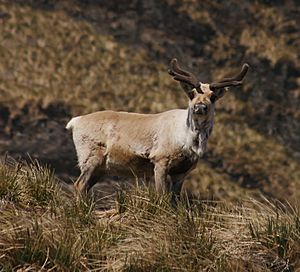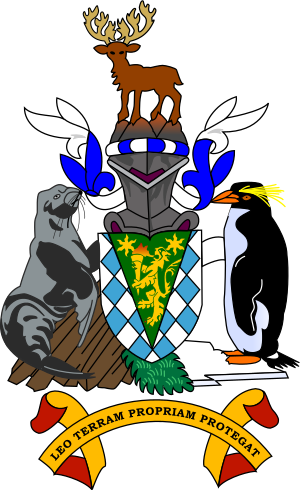Reindeer in South Georgia facts for kids
Reindeer in South Georgia are an example of an animal that was brought to a new place far from its natural home. These reindeer are a type of deer that usually live in very cold, arctic and subarctic areas. They were brought to the subantarctic island of South Georgia by Norwegian whalers in the early 1900s.
At first, the reindeer were meant for hunting fun and to provide fresh meat for the many people working in the whaling industry on the island. When whaling stopped in the 1960s, and most people left, the reindeer population grew a lot. They lived in two separate wild groups. Their large numbers started to harm the island's environment. Because of this, a decision was made to remove them all. This project happened between 2013 and 2015.
Contents
History of Reindeer in South Georgia
How Reindeer Arrived
In the early 1900s, South Georgia became the world's biggest whaling center. Many whaling stations were set up, like Grytviken and Leith Harbour. Having reindeer meant that people working there could hunt and get fresh meat.
The first reindeer arrived in November 1911. Brothers C.A. and L.E. Larsen brought three male and seven female reindeer from Hemsedal in southern Norway. They were set free at Ocean Harbour, which was a whaling station at the time. These reindeer started what was called the Barff herd. By 1958, this herd had grown to 3,000 animals. Later, their numbers went down, but they spread to new areas like Royal Bay.
A second group of reindeer came in 1912. The Christian Salvesen Company brought two males and three females to Leith Harbour. By 1918, this group had grown to 20 animals. Sadly, an avalanche killed the entire herd that same year.
The third group was brought in 1925. Three males and four females were released at Husvik Harbour. These animals started the Busen herd. Their numbers grew slowly at first, reaching 40 by 1953. Then, they increased quickly to about 800 by the early 1990s. These reindeer came from the same place as the Barff herd.
How Reindeer Numbers Grew
The Barff herd was far from people and grew very fast. Eventually, there were too many reindeer for the available food, and their numbers went down. The Busen herd, however, was closer to people. Its size stayed lower because people hunted them regularly. This changed when the whaling industry ended.
After whaling stopped in the 1960s, most people left South Georgia. Only a small military group, scientists, and tourists remained. There was little hunting or other human control over the reindeer. By 2010, the two herds were separated by glaciers that reached the ocean. They had about 2,600 animals living on 318 square kilometers. This was one-third of all the vegetated (plant-covered) land on the island.
During the removal project from 2013 to 2015, an accurate count showed that earlier estimates were too low. Nearly 7,000 reindeer were actually removed.
Moving Reindeer to Other Places
In 1971, a Royal Navy ship, HMS Endurance, took eight deer from South Georgia. The plan was to move them to Navarino Island in Chile. Seven of them made it safely.
To save the genes of the South Georgia reindeer and to help farming in the Falkland Islands, 59 young reindeer (26 males and 33 females) were moved from the Busen herd to the Falklands in 2001. The Falkland Island Government did this to start a commercial herd there. Their first babies were born in 2003.
A resident of the Falkland Islands, Jerome Poncet, also collected young deer in 2002 and 2003. He used his yacht, Golden Fleece, to move 31 young deer to Beaver Island in the Falkland Islands. These reindeer are still doing well there today.
Why Reindeer Were Removed
The reindeer were causing a lot of damage to the environment. Also, as glaciers melted, there was a risk that the reindeer could spread to other parts of the island. Because of this, a plan was made to remove them permanently. The decision was announced on February 19, 2011.
In January and February 2013, the Busen herd was removed. This herd lived in the Stromness Bay Area. About 2,090 reindeer were removed by herding them together and then slaughtering them for meat. In areas where herding was not possible, they were shot. About 7,500 kg of meat was collected. Also, 1,555 reindeer from the Barff herd were shot.
In January 2014, another 3,140 animals were shot in the Barff peninsula area. This time, the meat could not be sold, but some was used locally.
Over the next few years, small groups of up to 15 animals were found and shot by government experts. The last two were found in late 2017.
Reindeer Life and Habits
Reindeer breeding season, called rutting, was busiest between March 20 and 30. Calves (baby reindeer) were born in November. Male reindeer could have babies when they were 4 to 8 months old. Females could get pregnant for the first time when they were 16 to 17 months old.
On average, a generation of reindeer lasted 4.2 years. Males lived for about 7 to 8 years, and females lived for 11 to 12 years. Each year, about 30-40% of the reindeer died. The biggest problem for the population was finding enough food in winter. Starvation was a common cause of death. Many reindeer also died from falling off cliffs while trying to reach areas where there was still food.
How Reindeer Affected the Environment
The number of reindeer in South Georgia was much higher than in their natural homes. For example, in Svalbard in the Arctic, there are about 5 reindeer per square kilometer. In South Georgia, the numbers were much higher, from 40 to 85 reindeer per square kilometer in some areas.
The areas where reindeer lived on South Georgia had the most plants and different types of life. The reindeer caused serious damage. They ate too much of the native plants, like tussac grass and greater burnet. This led to soil erosion, a loss of different plant types, and the spread of invasive weeds. One such weed was the introduced grass Poa annua, which could handle being eaten more than the native plants.
Other Places Reindeer Were Introduced in the South
Not many reindeer have been brought to places in the southern hemisphere. One attempt in the late 1940s to bring them to southern Argentina failed when the animals were later killed. Another attempt to move reindeer from South Georgia to Isla Navarino, Chile, also failed. Seven of the eight animals died during the sea trip.
Besides South Georgia, the only other successful introduction was in 1954. Ten reindeer from Swedish Lapland were brought to the subantarctic Kerguelen Islands. These islands are a French territory in the southern Indian Ocean. By the 1970s, their population had grown to about 2,000.
See also
 In Spanish: Rangifer tarandus en Georgias del Sur para niños
In Spanish: Rangifer tarandus en Georgias del Sur para niños





